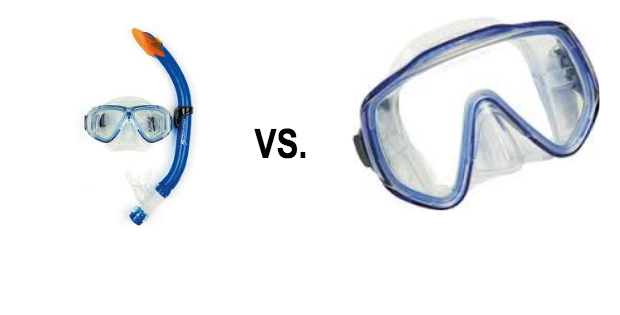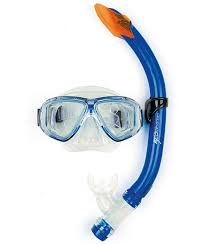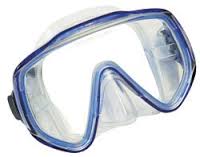The Great Snorkel Debate

To Wear a Snorkel or Not?
The following is a synopsis of an article on ScubaGuru.com by Tec Clark.
The on-going debate is whether or not to wear a snorkel when recreational scuba diving.
The “YES” Camp
#1: The snorkel allows the diver to conserve tank air pre or post dive when on the surface.
PRO: By using the snorkel at the surface you can maintain uninterrupted vision underwater while swimming or you can keep an eye on something underwater.
CON: If surface conditions are mild, the amount of tank air that is saved is minimal. However, if surface conditions are rough, you may be better off using the regulator to avoid heavy breathing. Also if swimming on the surface in rough conditions, it may be easier to swim with the regulator beneath the surface which will cut down on exhaustion that may set in. Finally, if you are waiting to board the boat and you are not one of the first, breathing through your regulator may help you avoid inhaling the boat’s diesel exhaust.
#2: The snorkel is essential for surface swimming if the tank has no air.
PRO: There is no doubt that if you are surface swimming a snorkel is preferable to no snorkel.
CON: Is swimming face-down on the surface while wearing scuba gear the most efficient way to swim? Many feel that it is more efficient to swim on your back. In this case the snorkel could be a hindrance. Most divers with a positively buoyant BC are easily able to swim on their backs while maintaining a controlled airway even in waves – as now the airway is above the water line instead of under it.
#3: It is a safety tool, there when you need it.
PRO: It is immediately available when needed at the surface.
CON: Check out the cons below, they outweigh the pro.
The “NO” camp
#1: It tugs on the mask and is unwieldy in a current.
PRO: The current may cause the snorkel to tug or pull on the mask strap causing the mask to leak and/or flood. The wobbling snorkel may be a nuisance as it moves and bumps equipment or the head.
CON: The design of the snorkel affects its movement. A more streamlined design can reduce the snorkel’s nuisance factor.
#2: It can easily get caught or entangled.
PRO: Having over a foot of plastic attached to the side of a diver’s head could be an object that gets bumped, caught or entangled. In overhead environments such as caverns, caves and wrecks students are emphatically taught not to wear snorkels for this very reason.
CON: Many pieces of a diver’s equipment protrude from their body. Those who have worn snorkels for a very long time have a great sense of their presence and rarely have an entanglement situation with their snorkels.
#3: It gets in the way during a dive.
PRO: During a recent rescue class a student went to put her Air II in her mouth during an air sharing exercise. As she brought it up to her mouth the snorkel mouthpiece came up on top of it! She put the wrong mouthpiece in and took in quite a gulp of water. This could have been disastrous. Sometimes the snorkel can be uncomfortable as it is hanging down next to the face and neck. This can be very distracting during a dive.
CON: Again, the profile of the snorkel and how it is worn has a lot to do with the comfort of wearing the snorkel. Most seasoned snorkel wearers have become very accustomed to the snorkel and do not perceive it as a nuisance.
THE HYBRID: “HAVING” A SNORKEL INSTEAD OF “WEARING” A SNORKEL
One solution that both camps often agree on is the use of a “collapsible” or “folding” snorkel. Several brands exist wherein the snorkel can be folded up and carried either in a BC pocket or attached to the BC during the dive, then deployed and attached to the mask strap at the surface when needed.
PRO: This seems to be the best of both worlds. It is not worn while underwater scuba diving, and it is there when you need it at the surface. It also works towards many training agency standards that call for a diving professional to carry a snorkel when teaching or supervising a dive.
CON: Although their flexible design works for storage, some can bend in surface currents/waves and squeeze down upon a strong inhalation. When you think of times when the snorkel may be needed, there is a strong chance that heavy breathing will accompany its use. To have a snorkel that restricts airflow, even slightly, leads to high CO2 levels and is also extremely frustrating. These folding snorkels can function as a snorkel in ideal conditions, but do they function well in robust situations? Not really. Many people give them good reviews for what they accomplish in theory, but when really used and put to the test they often come up short.
The “GREATER ISSUE”
#1: Modern day snorkels are huge! They have many features to make their use easier. With all of the features comes lots of plastic making them longer, heavier and bulkier.
#2: We’ve relied on technology to design an easier product. But as a result more and more divers are recognizing all the negatives to wearing these and are ditching them. And since many scuba classes downplay snorkeling so very much, the certified diver is often uncomfortable and not proficient with the snorkel to begin with (yet it was required to buy for their class).
Final Thought
For these reasons above it is no surprise why divers of the last ten years are shying away from wearing snorkels and why this is such an area of great debate.
Ah, to wear a snorkel, or not wear a snorkel… that is the question.












